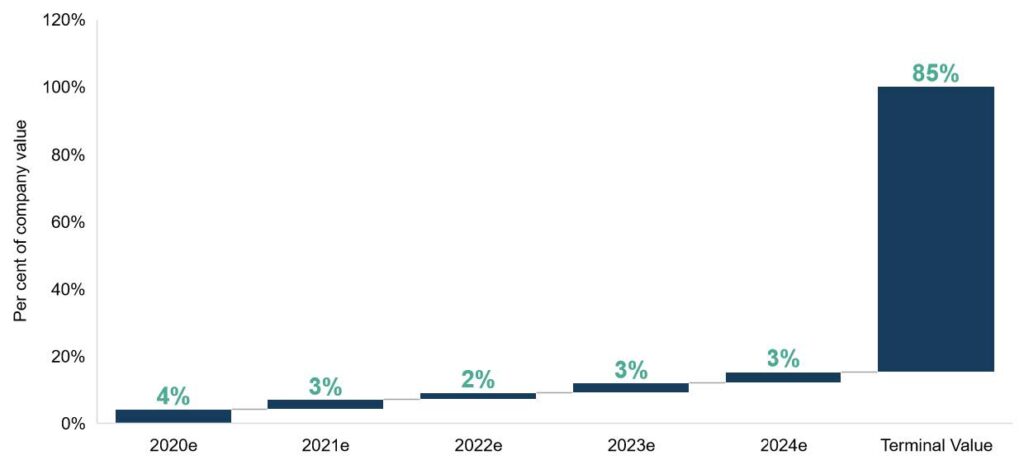To say the current market environment is tough to navigate is something of an understatement. It feels something like trying to plot a course through stormy seas, in darkness and heavy fog. As Tassilo pointed out in his newsletter last month, there are a lot of things that we simply do not know at this stage. While we keep abreast of developments and any changes to the unfolding crisis, ultimately we must stick to what we do know which, for us, is our companies. Fortunately, there are some tools of navigation on which we can fall back. We know our companies well, so we can make some reasonably accurate estimates as to how their values may have been changed by the effects of the coronavirus. Despite all of the turbulence, we find that these values are not as dramatically affected as the share prices suggest. This shows that in these times, even more than normal, price does not equate to value. The net result of this is that the future return profile of our funds has improved, which is good news for our investors.
You don’t need a degree in Economics to know that price is a function of supply and demand. For most goods there are certain constraints that prevent price fluctuating too far. So, despite the ludicrous levels of demand for loo paper in recent weeks, responsible supermarkets and consumer protection standards held the price in place. There were no such constraints on tulips in Amsterdam in 1637. Stock markets are closer to tulips than loo paper, in that there is no upper or lower bound to prices; extreme changes in supply and demand can therefore move share prices dramatically. The value of a company should remain much more consistent since it does have an upper and lower bound, set by relatively fixed variables, such as expected future cash flows, the value of assets and the level of risk. And yet, there is a tacit assumption that the share price of a company is a reliable indicator of its value.
Loyal followers of the efficient market hypothesis will agree with this assumption, arguing that the Market gives the best indication of a company’s value. The problem with this theory is that it assumes the investment community has perfect information and is rational. In fact, there are as many irrational investors as there are shoppers, all with their own assumptions and biases, often acting on imperfect information. The share price is merely the average of all these different opinions. At Seilern we value our companies principally by looking at the fundamentals of the business, not its share price. Nevertheless, while we hope that our long term approach will unearth value, we do often find that our valuations end up relatively close to the share price.
In times of financial stress, however, we find the dislocation between the two can become extreme. This is because the supply and demand of a stock is no longer mainly a function of the long term fundamental value of the business. Instead other factors are at play. The first is liquidity. Institutional funds may decide they want to shift their allocation to cash because of the uncertainty ahead. They may be forced to sell their holdings because of redemptions from investors. Hedge Funds may be forced to sell because of the heightened level of volatility which necessitates a reduction in position sizes. Retail investors may also seek cash because they feel they might need to save for tough times ahead. Regardless of the source, there is a greater demand for cash which leads to outright selling of shares, with little reference to the underlying value of the company. In this way, liquidity takes precedence over valuation. The second major factor is shortening time horizons. One of the key edges we believe we have over peers is being able to look out over the long term. We note that sell side research tends not to forecast more than three years out, whereas our companies can continue to generate earnings growth far beyond this. In times of stress, people start to think in terms of minutes and days, instead of months and years. Some investors may see a company with earnings cuts of 30-40% in 2020 and conclude that the share price should see an equivalent fall. As we will show below, this one-year effect equates to a relatively small portion of the total value for a Quality Growth company.
With this in mind, we turn our attention to our companies. Whilst there are various forces being exerted on share prices at the moment, we know that one of them remains the economic impact of the coronavirus.
We first need to figure out how their profits will be affected in the short and medium term, during the various lockdowns and quarantines. We then need to think about any longer lasting impacts from the pandemic, be it a more protracted recovery, or permanent changes in consumer behavior. When assessing how these changes will affect value, it is important to note that, for us, the value of a company is the sum of its future cashflows, discounted back to the present time at a reasonable rate (a DCF). Therefore, any decline in sales this year will lead to lower cash flows, and a lower overall value. We should reiterate here that our companies are chosen for both the quality and sustainability of their cash flows, as well as the belief that they can remain industry leaders for many years into the future. Due to this long duration, we find that approximately 85% of the value of a company comes from its cash flows more than five years out. So even if cash flows were to fall to zero for the next two financial years, we would only expect the value of the company to fall between five and twenty per cent. This range is based on the extent to which the company is able to recoup these cash flows once business activity returns to normal.
Figure 1: Distribution of value in average Universe company

It might be helpful to talk through this theory with one of our companies. IDEXX Laboratories is a healthcare company that sells diagnostic testing machines and kits to veterinarians around the globe. As global pet ownership continues to rise, and with 98% of owners in the US now seeing their pet as an important member of their family, the standard of care has risen, which all leads to greater levels of testing. This ‘humanisation of pets’ is a strong secular driver. As a result, pet care is seen as resistant to a normal recession, since people will want their animals to be healthy even when their incomes are falling. As with many other factors in this downturn, things will be a little different this time.
Due to social distancing and self-isolation, people may not physically be able to get to the vet. Clinics in the US will remain open since they are designated as essential services. IDEXX state that 60-70% of visits relate to sick animals, with the remainder coming from wellness check-ups. Annual blood tests to check for seasonal diseases such as canine heartworm, for example, are likely to be deferred until later in the year. We assume, more drastically, that only the most severe of sick cases will require a clinic visit while the most restrictive lockdowns are in place. This leads to a large fall in testing and consequently revenues in 2020. We estimate the net effect of our expected fall in profits to result in a 21% fall in our DCF derived value. (This is a larger fall than the average for our companies. The fall in earnings for 2020 still only has a small effect. But we are, conservatively, not expecting a rebound of pent up demand, since we assume many of these missed tests will not recur. This mechanically results in a lower base of cash flows going forward. Further, because IDEXX is a high growth company, the lower base has a larger impact on the terminal value than it would for a lower growth company).
If you were a believer in efficient markets, you would have thought that the share price would fall by roughly the same amount as the fall in value. And yet, in the thirty days between 19th February and the 20th March, the IDEXX share price had fallen 37%, almost twice the decrease in our DCF.
Figure 2: Fall in IDEXX value vs fall in share price, 19th February – 20th March

The final thing to add is that there may in fact be a more enduring, positive effect from the self-isolation and quarantine. During this time the only social interaction for some people will be with their pets. This will likely strengthen the trend for humanisation and may even encourage new pet owners. Indeed, Bloomberg reported last week that New York animal shelters are seeing a surge in pet adoption applications. This is not something we have factored into our numbers and is certainly not being considered by those who were selling IDEXX with the rest of the market.
We already know that the companies in which we are invested have strong balance sheets providing the necessary ballast to sail on through these turbulent times. We find that returning to the underlying value of our companies can provide an additional tool to help us make informed decisions. The case of IDEXX gives a real-life example of the theory behind our valuations. In the past few weeks, as we have tried to update our models for the potential economic impact of this deadly virus, we have found similar overreactions across other companies within the Seilern Universe. We therefore see some bright spots on the horizon behind the falling share prices, since the future return profile of our funds has improved. For long term investors, the opportunity is slowly becoming clearer, even as choppy seas remain ahead.
This is a marketing communication / financial promotion that is intended for information purposes only. Any forecasts, opinions, goals, strategies, outlooks and or estimates and expectations or other non-historical commentary contained herein or expressed in this document are based on current forecasts, opinions and or estimates and expectations only, and are considered “forward looking statements”. Forward-looking statements are subject to risks and uncertainties that may cause actual future results to be different from expectations.
Nothing contained herein is a recommendation or an offer or solicitation for the purchase or sale of any financial instrument. The material is not intended to provide, and should not be relied on for, accounting, legal or tax advice, or investment advice. The content and any data services and information available from public sources used in the creation of this communication are believed to be reliable but no assurances or warranties are given. No responsibility or liability shall be accepted for amending, correcting, or updating any information contained herein.
Please be aware that past performance should not be seen as an indication of future performance. The value of any investments and or financial instruments included in this website and the income derived from them may fluctuate and investors may not receive back the amount originally invested. In addition, currency movements may also cause the value of investments to rise or fall.
This content is not intended for use by U.S. Persons. It may be used by branches or agencies of banks or insurance companies organised and/or regulated under U.S. federal or state law, acting on behalf of or distributing to non-U.S. Persons. This material must not be further distributed to clients of such branches or agencies or to the general public.
Get the latest insights & events direct to your inbox
"*" indicates required fields





